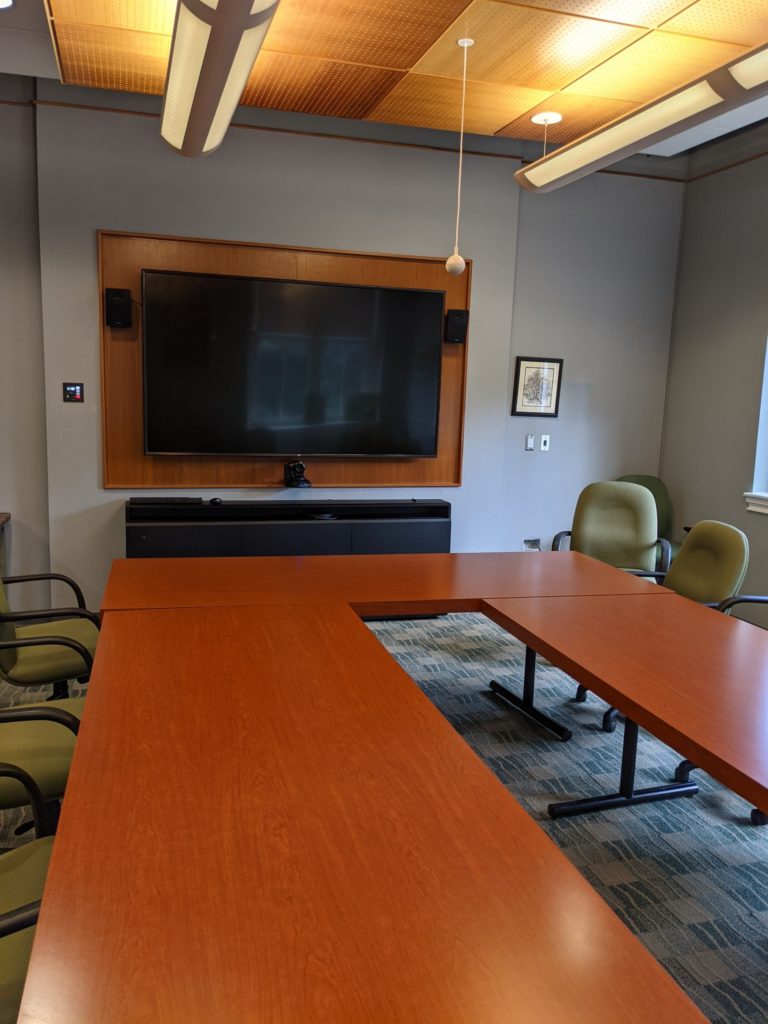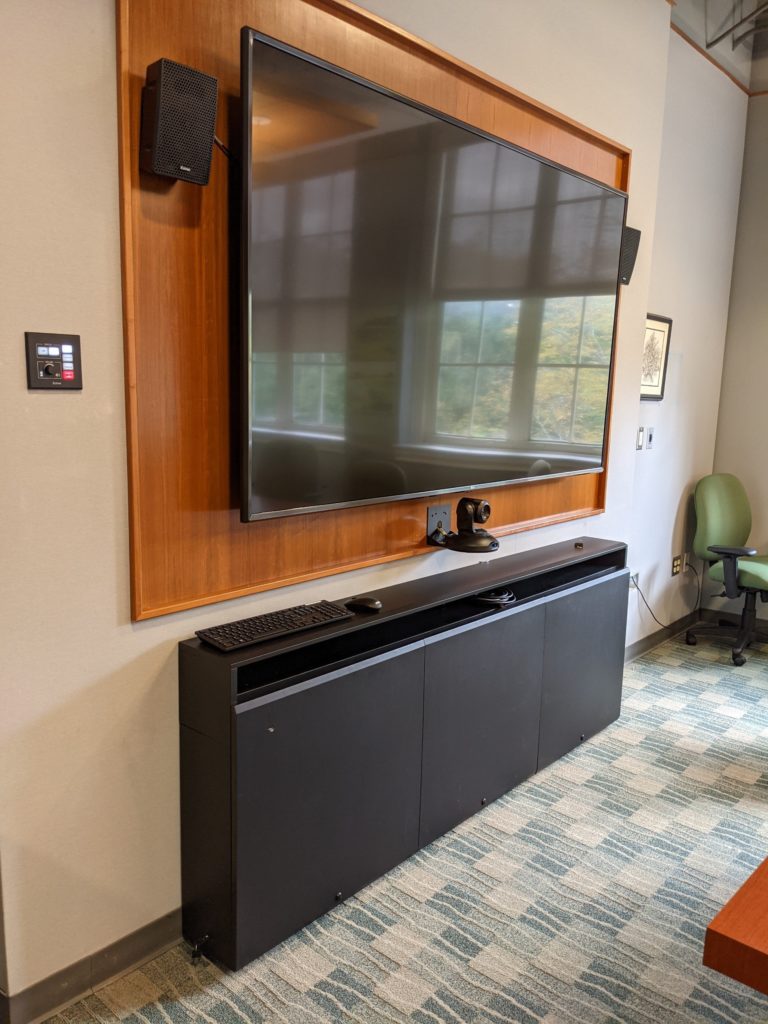In the previous articles in this series, we discussed both the criteria we’ll be using to assess the effectiveness of furniture in technology-rich learning environments as well as the categories of furniture we’ll review. We defined technology-enabled furniture as purpose-built to provide dedicated and permanent locations for technology necessary to the operation of the learning space, and identified the five criteria for evaluation as standardized connections, equipment mounting, cable routing, field serviceability, and ADA compliance. Please see the Spring 2021 and Summer 2021 issues of essentials for more information.
In this article, we’re going to review furniture that isn’t often thought of in terms of learning spaces, but is just as common as a lectern or student workstation on our campuses. We’re going to look at conference room furniture, specifically conference tables and credenzas.

Conference tables are usually outside the scope of the IT and AV systems for conference rooms, and yet could be considered a vital technology-enabled component as they’re the furniture pieces with which the users interact the most and where users want the AV connections located. To be honest, in most conference rooms, the users want the AV to be invisible (i.e. wireless), but they also want the full complement of functions for presentations, video conferencing, and content sharing, and the technology necessary for those functions has to live somewhere. We don’t like putting holes in new tables to mount equipment, so whenever the space and budget allows, we’ll recommend a credenza to host the majority of the technology equipment, minimizing modifications to the conference table itself.
In addition, adding a credenza to a conference room can complicate matters as it means adding cabling pathway between the conference table and the credenza, as well as to locations for the display(s) and audio system. Even with that added complication and cost, credenzas are generally better suited for housing technology equipment and are preferable to mounting the requisite technology devices to the bottom of the conference table.
However, if the space and budget requires the technology equipment be located at the conference table location, then there are options to provide appropriate connectivity, mounting locations, wiring pathway, easy access for maintenance, and ADA compliance.

Cable connectivity in conference tables often requires a dedicated table-top device that can also be hidden out of the way to present a clean appearance when the technology is not in use. Simply providing an access hole with a simple plastic grommet in the top surface of the table isn’t sufficient as the cables must have a place to go when not in use, which can be especially difficult on larger tables when the cables must be long enough to reach users seated on either side and even the ends of the table. Specialized pop-up columns, or flip top or sliding covers on the table-top devices and retractable cable assemblies can help with this, but also can dramatically increase cost. Additionally, table-top devices must provide AC power (in the form of NEMA 5-15 110VAC receptacles), which should have separate pathway to minimize electromagnetic interference between the AC power and the low voltage devices connections (HDMI, USB, LAN, etc.), and can complicate mechanical retractor systems. Of course, extra cable lengths can be eliminated completely by providing standard low-voltage inserts such as keystone, Decora (aka decorator), or D-series (aka D-style or D-type) disconnects, but that means the cables themselves must be stored somewhere in the room and available to users.
Mounting equipment to conference tables presents additional challenges due to the nature of the furniture itself. While some conference tables are available with dedicated equipment columns or pedestals, they seem to be the exception, rather than the rule, and most often technology equipment must be mounted directly to the underside of the table itself. Modern conference rooms require all the same capabilities as a classroom, in order to avoid mounting an entire equipment rack’s worth of metal boxes to the underside of the table, the best alternative is often a dedicated credenza.
Credenzas are commonly found in two form-factors: larger sizes that can host a standard-width 19” or 10.5” (aka half-rack) telecommunication equipment racks (or is actually an equipment rack with finished panels over to present the appearance of an elegant piece of furniture) and slim sizes that are designed to be placed directly below a display. Larger credenzas can obviously host more equipment and provide better access for cabling and maintenance, but they require more space. Slim credenzas are better for smaller spaces, but are also limited in the amount of equipment they can host as well as potentially limit the equipment that end users can easily access.
On the topic of maintenance, considering the expected lifespan of most conference room furniture will exceed that of the technology, all the AV components will likely be repaired, removed, replaced, upgraded, or troubleshot multiple times, so credenzas and any equipment locations under conference tables should have easily removable panels.
Keep in mind that when pairing a conference table with a credenza, the cable pathway between the two locations is critical. While it may be (relatively) easy to plan for a floor poke device below a conference table and conduit to a wall box behind a credenza, the overall distance between those locations will affect cable lengths and thus the amount of equipment necessary to transmit and receive those signals which in turn may mean additional space under a conference table or in a credenza to house the equipment.
Within a credenza as well as under a conference table (and especially inside any central equipment pedestals or columns), adequate cable pathway is crucial. Technology components can have as many as a dozen wiring connections between them, so even three or four modules can quickly create a wiring mess if there’s not proper access between them. A single large passthrough is far preferable to several smaller holes cut between equipment locations and multiple large passthroughs are even better. Basically, as long as you don’t compromise the structure of the furniture piece, keep cutting holes.
On the topic of maintenance, considering the expected lifespan of most conference room furniture will exceed that of the technology, all the AV components will likely be repaired, removed, replaced, upgraded, or troubleshot multiple times, so credenzas and any equipment locations under conference tables should have easily removable panels. Detachable panels are always preferable to hinged doors and the more panels that can be removed, the better. Some credenzas, as previously mentioned, are basically equipment rack frames with decorative panels attached, which allows for a great deal of access to internal equipment and wiring for maintenance. Similarly, some conference table pedestals are assembled in such a way that almost every finished panel can be removed to provide almost 360-degree access to the equipment and wiring. These features are real time savers for local IT staff.
ADA compliance does raise some questions: How wide can the table be and still provide adequate reachable access to any cables, control devices, or power locations in table-top devices? (Answer: 36 inches.) How can equipment be mounted to the underside of a conference table without impacting the ability for a user in a wheelchair to sit at any location? If a credenza isn’t part of the conference room furniture or the credenza isn’t located directly below the display, then the display can extend no more than 4” off the wall, which makes it very difficult to mount almost any equipment behind the display.
Almost every use of conference rooms increasingly includes video conferencing and content sharing and so the conference tables (and their matching credenzas) must also support those technologies. Modern conference room furniture designed for the modern conference room will incorporate standardized cable and equipment mounting locations, ample access and pathway for cable management, removable panels and covers, and meet all necessary ADA requirements.
Special thanks to Jamie Rinehart, University of Missouri-Kansas City; Marc Cholewczynski, Oregon State University; Rachel Bradshaw, Caster Communications; Larry Darling, University of North Carolina Greensboro; and Justin Rexing, Western Kentucky University for their insight on this topic.

